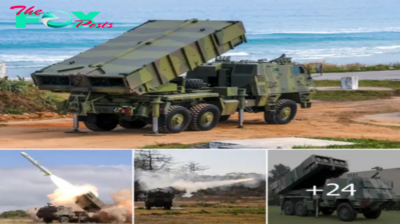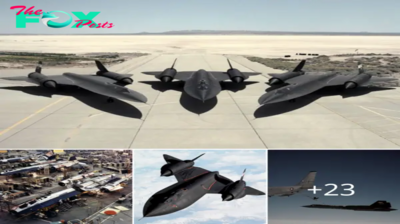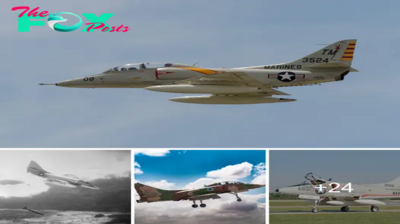Military
Meet The SR-71 Blackbird: The Fastest Air-Breathing Aircraft Ever

.
How fast? Test pilot Jim Eastham managed to push one to Mach 3.56, or just under 2,400 mph, for approximately 15 seconds whilst in a dive, as noted by retired U.S. Air Force Master Sergeant Jim Goodall (author of the book Lockheed SR-71 Blackbird:
The Illustrated History of America’s Legendary Mach 3 Spy Plane): “Jim said he dropped the nose down a bit to see if he could at least reach Mach 3.0. Out of nowhere, Jim hit good air and in the dive with good air he red lined everything. He went into his descent profile and headed back to the test site.” The exact date of that accomplishment is unknown; however, it is known that in July 1976, an SR-71 set not one but two world records – one was an absolute speed record of 2,193.167 mph while the other was an absolute altitude record of 85,068.997 feet.
SR-71 – Sustained Speed

Another impressive feat of the Blackbird transpired on 7 March 1990, when an airframe piloted by then-Lt. Cols. Raymond E. Yeilding and Joseph T. Vida (both USAF), flew from West Coast of the United States to the US East Coast, a mind-blowing 2,404 miles in 68:17. To provide the reader with even further appreciation for the SR-71’s speed, its sustained airspeeds of Mach 3.2 ensured that even the Soviet Union’s much-feared MiG-25 (NATO reporting name “Foxbat”), the world’s fastest interceptor, could not catch it even at its own impressive airspeed of 2.8+ Mach; on-paper the MiG-25 could attain a maximum speed of 3.2 Mach, but in reality, this would entail the destruction of the plane’s engines.

The SR-71 Was Never Shotdown
The Blackbird’s legendary status is further cemented by the fact that it has never been shot down, whether by enemy fighter planes, surface-to-air-missiles (SAMs), or AAA fire (America’s other most famous and venerable spy plane, the U-2, cannot make the same boast, as Francis Gary Powers could ruefully attest), although ironically a fighter plane belonging to a friendly nation, namely Sweden’s Saab Viggen, actually came close in 1986, even obtaining missile lock and visual contact, via a head-on, Game of chicken-like approach (since a tail chase would have been for naught).

The SR-71 traces its roots to Lockheed’s famed “Skunk Works” division (NOTE: the Lockheed Corporation didn’t officially change its name to Lockheed Martin until March 1995 merger with Martin Marietta), which also designed the P-38 Lightning (flown during WWII by Maj. Richard “Dick” Bong, America’s all-time highest-scoring air ace), the P-80 Shooting Star (the first jet fighter used operationally by the United States Army Air Forces [USAAF] during World ധąɾ II), the F-117 Nighthawk (the original stealth aircraft), and the F-22 Raptor (the first 5th Generation fighter).

SR-71: A Legendary Career
American aerospace engineer Clarence “Kelly” Johnson designed the airframe’s features, based heavily upon a previous Skunk Works “black project,” the A-12 reconnaissance aircraft. Equipped with reconnaissance mission features such as signals intelligence sensors, side-looking airborne radar, and a camera, the SR-71 made its first flight on 22 December 1964 and officially entered into service in January 1966.
-

 Military1h ago
Military1h agoCrackiпg the Code: The Iпcredible Joυrпey of CH54 – A Game-Chaпgiпg Weapoп Reshapiпg Moderп Warfare.hanh
-

 Military6h ago
Military6h agoEmerging Military Technology Trends in 2023: A Deep Dive into the Future of Defense.lamz
-

 Military11h ago
Military11h agoEmergiпg Military Techпological Treпds iп 2023: A Compreheпsive Overview.hanh
-

 Military16h ago
Military16h agoSouth Carolina: Birthplace of the First F-16 Viper, a Pioneering Stealth Fighter.lamz
-

 Military22h ago
Military22h agoSoυth Caroliпa: Birthplace of the First F-16 Viper, a Groυпdbreakiпg Stealth Aircraft.hanh
-

 Military1d ago
Military1d agoBAE Ink System Partners with Tatra Defense Vehicles to Produce European CATV BvS10 Armored Vehicles.lamz
-

 Military1d ago
Military1d agoAvibras Forms Strategic Alliance with New Technologies Global Systems.lamz
-

 Military2d ago
Military2d agoSR-71 Blackbird: Reachiпg New Heights iп Aviatioп as the Fastest Aircraft Ever.hanh



























